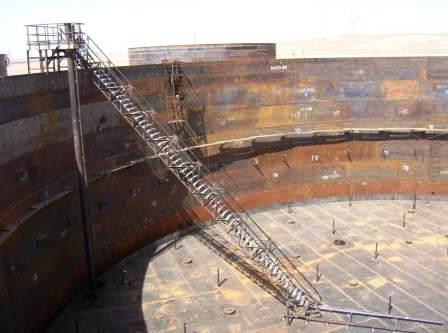What to Expect Throughout a Thorough Tank Welding Inspection
A Comprehensive Review of Tank Welding Assessment Requirements and Methodologies for Improved Weld Quality and Efficiency
The importance of welding evaluation criteria in the manufacturing of storage tanks can not be overstated, as they serve as the foundation for making certain weld stability and operational dependability. Different assessment methods, including aesthetic analyses and progressed non-destructive testing approaches, are essential in recognizing prospective problems that can endanger efficiency.
Value of Welding Inspection Requirements

Welding inspection standards include a variety of requirements, consisting of material specifications, welding treatments, and qualifications of workers associated with the welding process. By applying these standards, companies can systematically determine and correct prospective issues, thereby minimizing the likelihood of expensive repair services or catastrophic failings. Rigorous evaluation methods foster a culture of accountability and accuracy, encouraging welders to preserve high degrees of workmanship.

Common Welding Evaluation Methods


Ultrasonic Examining (UT) is an additional common technique, utilizing high-frequency acoustic waves to find interior flaws that might not be noticeable externally. This approach is particularly reliable for identifying voids or incorporations within the weld metal. Magnetic Particle Examining (MT) is likewise extensively made use of, particularly for ferromagnetic products, as it exposes surface and near-surface issues with the application of magnetic fields and ferrous particles.
Furthermore, Liquid Penetrant Testing (PT) detects surface-breaking issues by using a penetrant to the weld and afterwards utilizing a developer to extract the penetrant. Each of these techniques adds to an extensive assessment technique, ensuring that welds fulfill the stringent quality standards needed in tank building.
Regulative Standards and Conformity
Regulatory requirements and conformity are vital components in making certain the security and dependability of welded structures in tank building and construction - Tank Welding Inspection. These requirements offer to establish minimum demands for product homes, welding treatments, and evaluation methods, therefore decreasing the threat of architectural failures and improving total performance
Key companies, such as the American Culture of Mechanical Engineers (ASME) and the American Welding Society (AWS), supply standards that are widely adopted in the market. Conformity with these criteria not only guarantees adherence to finest techniques yet also satisfies legal and legal commitments, safeguarding the interests of stakeholders.
Regulative bodies commonly mandate adherence to details codes, such as ASME Code Section IX for welding qualifications and API 650 for welded storage tanks. These codes detail demands for welding strategies, credentials of employees, and testing methods to verify weld integrity.
Regular audits and evaluations are vital to preserving conformity, as they assist determine variances from developed criteria. Non-compliance can cause substantial fines, task hold-ups, and security dangers. Therefore, a robust understanding of regulative standards and a commitment to compliance are paramount in attaining high-grade and sturdy bonded storage tank structures.
Non-Destructive Evaluating Methods
How can the integrity of welded structures be assured without creating damages? Non-destructive testing (NDT) methods supply a durable option, allowing inspectors to review weld top quality without compromising the product - Tank Welding Inspection. Amongst one of the most usual NDT strategies are ultrasonic screening (UT), radiographic testing (RT), magnetic fragment testing (MT), and dye penetrant screening (PT)
Ultrasonic screening employs high-frequency audio waves to find interior flaws and identify material residential or commercial properties. It provides specific dimensions and is especially effective for thick products. Radiographic testing entails passing X-rays or gamma rays with the weld, creating pictures that reveal architectural problems such as splits or spaces. This technique is important for analyzing the stability of complex welds.
Magnetic bit screening is suited for ferromagnetic products, where magnetic areas disclose surface look these up and near-surface stoppages. Dye penetrant screening utilizes a liquid color to highlight surface-breaking defects, making it an effective technique for non-porous products.
Each of these NDT approaches has distinctive advantages, enabling thorough evaluations customized to specific materials and welding procedures. By implementing these methods, sectors can ensure the dependability and safety and security of bonded structures, eventually improving overall performance.
Enhancing Weld Top Quality Through Evaluation
Efficient assessment plays a crucial function in boosting weld top quality, acting as an important checkpoint in the construction process. By determining prospective flaws early, examinations reduce the danger of jeopardized architectural stability and make certain conformity with industry standards. Employing a combination of visual examinations, non-destructive testing (NDT) methods, and mechanical assessments, inspectors can discover over here problems such as porosity, fractures, and insufficient blend.
Implementing a durable examination method not just boosts the total top quality of welds yet likewise promotes a culture of accountability among welders and fabricators. Routine training and Website qualification of evaluation employees ensure that they are furnished with the required abilities to identify and attend to prospective troubles successfully. This positive approach minimizes rework and linked costs, inevitably adding to project effectiveness.
Moreover, detailed documents of inspection findings provides beneficial insights right into reoccuring concerns, assisting in continuous improvement in welding techniques. By leveraging sophisticated technologies, such as automated ultrasonic screening or digital radiography, weld quality can be boosted with much more specific examinations. In final thought, a rigorous assessment process is indispensable in accomplishing premium welds, ensuring security, dependability, and longevity in storage tank fabrication.
Final Thought
In verdict, the execution of rigorous storage tank welding assessment criteria and methodologies is vital for making sure weld honesty and performance. By using a combination of visual assessments, non-destructive screening approaches, and adherence to regulative requirements, companies can properly recognize and mitigate potential problems.